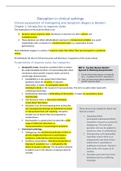Summary
Summary Deception in clinical settings (PSB3E-M13) (articles and chapters)
- Course
- Institution
Summary of the articles and selected chapters that are on the readinglist of the course Deception in clinical settings, which is a third year psychology course at the University of Groningen. I wrote this summary in , although I have heard from multiple student that the articles from those years al...
[Show more]



